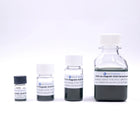Table of Contents
- Lateral Flow & Diagnostics
- Imaging Technologies
- Nanomedicine
- Nanotoxicology & Nanosafety
- Photothermal Therapies
- Plasmonic Nanoparticles
- Reference Materials
- Sensing Applications
- Special Effects Pigments
- Surface Enhanced Spectroscopy
Nanoparticles for Lateral Flow & Diagnostic Applications
Nanoparticles play an important role in a wide range of diagnostic devices and testing methods to increase performance (e.g. sensitivity, speed) or to enable a detection method that would not be possible without nanotechnology. Plasmonic nanoparticles are extremely strong absorbers and scatters of light and are used in lateral flow diagnostics, surface enhanced spectroscopy, cell labeling, and color changing sensors. Nanoparticles with electrochemical, magnetic, or fluorescent properties response are also used in many different diagnostic applications.
Nanoparticles for Imaging Technologies
Plasmonic nanoparticles can be engineered to have very high scattering cross sections that allow sub-100 nm diameter particles to be easily detected with a standard dark field microscope. Multiplexed imaging is accomplished by using plasmonic nanoparticles with different colors due to their material, size and shape. Nanoparticles can also be fluorescently labelled and this fluorescence can be enhanced by using a plasmonic particle that functions as a nanoscale antenna for increasing the fluorescent brightness. Many other nanoparticle imaging formats are also utilized, including Raman labels that provide a unique fingerprint for highly multiplexed imaging applications and magnetic nanoparticles that have high contrast for MRI scans.
Click here to view our collection of products that can be used for imaging technologies.
Nanoparticles for Nanomedicine
Many promising therapies are limited by the inefficiencies of drug delivery. Encapsulation of a drug within a nanoparticle can increase efficacy and reduce toxicity by providing greater control over release rate, or by triggering the release at a particular time or location. By controlling the size, shape, surface, charge, and biodegradability of various types of particles, nanomedicinal formulations have shown efficacy in the clinic with many magnetic particle, liposome and nano-polymer based therapies approved for human use.
Plasmonic nanoparticles can be tailored to strongly absorb specific wavelengths of light and have shown promise for photothermal therapies (acne treatment, hair removal, skin cancer therapy). Hollow and porous nanoparticles can be chemically functionalized to bind drug molecules and then subsequently release the drug when the particle reaches its target. Magnetic components provide strong MRI contrast agents and can be integrated into composite theranostic particles that both deliver drugs and track the therapeutic within the body.
Click here to view our collection of products for nanomedicinal applications.
Nanoparticles for Nanotoxicology & Nanosafety
Nanotoxicology is the study of the toxicity of nanomaterials and focuses on how the size and unique properties of nanoparticles influences their impact on human health and the environment. Nanosafety is a field that aims to understand the physical and chemical characteristics that can be engineered into a particle in order to maximize its safety. Together these two disciplines provide fundamental research results to support the rapidly increasing use of engineered nanoparticles in ways that are safe and sustainable.
To understand the structure-activity relationship of nanoparticles interacting with biological systems, it is important to conduct studies with precisely engineered nanomaterials that are highly characterized. By performing a set of experiments where only a single characteristic of the nanoparticle is altered, trends associated with that characteristic can be determined. Understanding the effect of each parameter allows for generalizations to be made for the more complex and relevant nanoparticles that are being produced and utilized at industrial scales.
Click here to view our collection of products intended to support the nanotoxicology community.
Nanoparticles for Photothermal Therapies
Hyperthermia uses heat as a non-chemical treatment for disease. Plasmonic nanoparticles are extremely efficient at absorbing light in the visible/infrared regions of the spectrum and releasing the energy as heat. Many plasmonic photothermal therapies are in clinical trials including treatments for head and neck cancer, light-pigmented hair removal, and acne therapy. A related application that we are actively researching is how to use the photothermal properties of nanoparticles to rapidly thaw frozen embryos and tissue without damage.
Infrared absorbing plasmonic nanoparticles efficiently convert laser light into heat. Gold nanorods, gold nanoshells, and silver nanoplates can all be engineered to efficiently absorb light at target wavelengths (typically, 600 nm–1100 nm). Magnetic nanoparticles can also be used in hyperthermia applications by heating with radio frequency (RF) fields, and thus have the advantage of much deeper penetration of the heating energy compared with light penetration into the body. Typically, particles are surface functionalized to provide stability and biocompatibility.
Click here to view our collection of products for hyperthermia and photothermal therapies.
Plasmonic Nanoparticles
Plasmonic metal nanoparticles – including gold, silver, and platinum – are highly efficient at absorbing and scattering light. By adjusting the nanoparticle size, shape, and composition, the color can be tuned from the ultraviolet through the visible to the near-infrared regions of the electromagnetic spectrum. Gold nanoparticles are ruby red and silver nanoparticles are a vibrant yellow. Plasmonic particles with other shapes have even broader color tenability. Additionally, the plasmonic nanoparticles can be engineered to be extremely strong absorbers (e.g. efficiently convert light to heat for photothermal therapies) and also very efficient scatters (e.g. for biodiagnostics).
NanoComposix has one of the world’s largest libraries of plasmonic nanoparticles across a broad range of sizes, shapes, surfaces and materials. Each nanoparticle is provided with a specification sheet that correlates the particle geometry to the optical spectra. Plasmonic particles can be surface functionalized for integration into a wide variety of solvents and coatings. By attaching an antibody or other targeting agent to the particle surface, the plasmonic nanoparticles can be used for nanomedicine and diagnostic applications. Core/shell plasmonic structures combine the benefits of the plasmon resonance with fluorescent and magnetic functionality.
Click here to view our collection of plasmonic nanoparticles.
Nanoparticles as Reference Materials
Reference materials are critical for checking the quality and metrological traceability of products, validating analytical measurement methods, and for instrument calibration. One challenge of nanoparticle reference materials is that the particle’s small size can lead to changes in the material properties over time. Nanoparticles also have different characteristics when compared to larger bulk materials or chemicals that must be fully quantified and monitored.
The composition, size, shape, charge and surface chemistry of nanoparticles are critical properties that need to be tightly controlled and measured during fabrication for any nanoparticle reference material. To ensure colloidal stability, the degree of particle aggregation and corresponding hydrodynamic size needs to be known and tracked with time. The concentration of all elements – both from the constituent materials of the nanoparticle and any residual chemicals in solution – must be quantified. In addition, measurement of the optical properties, surface area, solution pH, and endotoxin levels are also important for many reference materials.
Click here to view our collection of nanoparticles that can be used as reference materials.
Nanoparticles for Sensing Applications
Nanoparticles can be used as sensors to detect the presence of molecules that come into contact with the nanoparticle surface. When the particle surface is functionalized with a targeting ligand, molecules can be recognized and captured, resulting in a shift in the optical spectra of plasmonic nanoparticles, referred to as surface plasmon resonance (SPR) spectroscopy. In addition to SPR-based sensors, nanoparticles can be used in other sensor formats where environmental changes induce a response in the particle electrochemical, mechanical, or conductivity properties that can be detected and quantified.
Plasmonic nanoparticles have a color that is a function of their material composition, size, shape and surface chemistry. To function as a sensor, binding events or changes in the environment induce a measurable shift in the optical properties of the particle. Very small quantities of analytes can be detected through the use of certain particle shapes and patterned films. Other sensor detection methods rely on the aggregation of plasmonic nanoparticles in solution, or changes in the size or shape of nanoparticles in response to the environment that gives rise to a change in their optical properties. Silver nanocubes on a metal substrate are extremely sensitivity to molecules at the cube/surface interface.
Click here to view our collection of products that can be used for sensing applications.
Nanoparticles as Special Effects Pigments
Special effect pigments provide unusual optical effects that are used for a variety of applications including jewelry, cosmetics, and coatings. Birefringent, pearlescent and angle-dependent color are all possible through the selection and orientation of nanoparticles. Structural color is another class of pigments where the color is obtained through the periodic ordering of nanoscale features, similar to the opalescence of a butterfly wing.
Plasmonic nanoparticles have unique optical properties that are a function of the size and shape of the nanoparticle. A solution of gold nanoparticles is ruby red in color while silver is a vibrant yellow. By using other shape geometries such as rods, plates and shells, the optical response can be tuned throughout the visible and infrared regions of the spectrum. An unusual property of plasmonic nanoparticles is that the relative contributions of scattering and absorption is a function of the nanoparticle size, allowing for an additional level of control over the perceived color and appearance. In addition to plasmonic effects, artificial opals – colloidal crystals of uniformly sized nanoparticles – have unique color effects due to photonic effects.
Click here to view our collection of products that can be used as special effects pigments.
Nanoparticles for Surface Enhanced Spectroscopy
Metal nanoparticles support localized surface plasmon resonances, collective oscillations of conduction electrons that strongly couple to light at specific wavelengths and produce extremely high electromagnetic fields near the nanoparticle surface. Surface Enhanced Raman Scattering (SERS) can increase the Raman signal by more than 6 orders of magnitude. Fluorescent molecules near the metal particle surface can also be enhanced and can be protected from photobleaching in an effect known as Surface Enhanced Fluorescence (SEF).
For SERS applications, plasmonic nanoparticles with areas of high curvature produce the largest field enhancements (e.g. rod, cubic, pyramidal, or plate geometries). Controlled aggregation of particles into doublets or triplets also produce high enhancements, especially when the SERS molecule can be trapped in the junction between the particles. For SEF, the fluorescent molecules also need to be in high localized field but if the fluorescent molecule is too close to the metal surface, its emission can be “quenched”. Thus, SEF particles are engineered to position the fluorescent molecule a few nanometers away from the particle surface.
Click here to view our collection of products that can be used as starting materials to facilitate surface enhanced spectroscopy.




